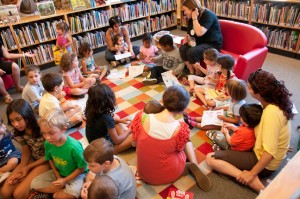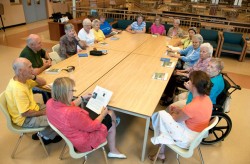Your Public Library is Hot!
Once upon a time the public library was like a cathedral, where patrons came and went in reverent silence. Not anymore. Today’s library is action central.

Young kids and their parents enjoy the regular drop-in story and craft time at Albion Bolton branch. Photo by Pete Paterson.
Mary Maw is explaining her role as manager of communications and programming at Caledon Public Library. She and a team of four are responsible for community outreach, organizing special events, and developing and managing programs. But that’s just for adults, she says. Another team does the same for children and teens.
Then almost as an afterthought, Mary adds, “But we also do the marketing.” Marketing? At a library? What is there about a public library that needs marketing? More than most of us can possibly imagine it seems. The public library is no longer the place our grandparents knew.
Over relatively few years libraries have moved far beyond the more or less one-dimensional role they once played. Today they generate so much activity for every age and interest that in some ways they are far ahead of the public they serve, and marketing has become necessary to get the word out.
Caledon’s chief librarian Bill Manson puts it this way: “Every library I’ve ever worked in has this recurring complaint: ‘If only they knew what we’re doing, they’d use it!’ So the mandate I gave the team is that I never want to hear that.”
And the team seems to have taken that mandate effectively to heart – year over year library use has continued to grow. In the words of a former executive with the Ontario Library Association, “Caledon’s library shot up over the horizon a few years ago and, given its size, it has become quite a leader. What’s exciting is that this phenomenon is happening almost everywhere. Libraries like Caledon’s have become community cultural centres, and in today’s world that’s what they should be.”
According to futurist Thomas Frey of the DaVinci Institute, a community cultural centre taps into the spirit of a community with resources and activities to support what the community deems important. But then it goes further to expose the community to things it didn’t even know about.
Caledon’s library has firmly embraced this role. Its quarterly publication “Books and Beyond” and its newly redesigned website (caledon.library.on.ca) – along with its Facebook, Twitter and YouTube feeds – outline a veritable blizzard of events and activities.
Among them is a host of activities for children and teens. This past summer’s offerings included the TD Summer Reading Club for all ages and a Battle of the Books for teens in which they read eight books and voted for their favourite (this year’s winner, Divergent by Veronica Roth). This fall the Discovery Club starts up again, where children six to ten participate in reading and hands-on activities related to math, music and science. And come December, all branches offer opportunities for writing letters to Santa. Family drop-in times for stories and games run year-round.
These and other kids’ programs are the kind of activities designed to introduce a whole new generation to the library’s treasure trove, but long-time patrons and new adult members are equally well served. Along with its traditional book-lending role, the library hosts book clubs, including three especially for seniors, creative writing workshops, poetry, photography and short story contests for teens and adults, art shows and information seminars.
Many of its programs are conducted through community partnerships. In a partnership the library provides space, resources, promotion and more to a community organization. The organization, in turn, draws people to the library. It’s an ideal way for a public, tax-supported institution to nourish and reinforce the three concepts of community, culture and centre. Some partners, especially non-profit ones, are obvious matches. Caledon’s Meals on Wheels and Caledon Community Services, for example, have found the Caledon Library’s seven branches a valuable way to introduce their services across a diverse municipality.
New this fall is a partnership with Volunteer MBC. The monthly program at Albion Bolton branch will explain community volunteer opportunities within various non-profit organizations.
Even commercial partnerships have produced exciting outcomes. The library’s Young Reels program, for example, is conducted with the Empire Theatre in Bolton. Videos made by young people get to be professionally screened on a special day at the theatre.
“Essentially,” says Mary Maw, “when it comes to partners, in fact when it comes to any kind of activity or information, if it’s worthwhile and there’s community benefit, the library will find a way to make it work.”
Then she adds, “Incidentally, when you’re enjoying the library, bring along your used batteries and your outdated tech. We’ve got a community recycling program too.”
The recycling program is a partnership with several recycling organizations. As well as participating in a variety of eco-projects, the library branches have become collection depots not only for used books, which it resells at the annual Monster Book Sale, but for discarded cell phones, digital cameras, laptops, batteries and the like.
You could argue the library is making a self-satisfied point by collecting tech-junk. That’s because there’s a widely held perception that technology is making libraries redundant to the point of threatening their very existence. In fact, technology has generated quite the opposite outcome.
For instance, compare the traditional position of libraries on reading skills with their contemporary attitude toward tech skills. While libraries have always preserved and promoted literacy, the implicit assumption is that most patrons can already read. There’s not much guidance needed for how to use a book. But if Caledon’s library is any indication, the situation is quite different on the technology side.
Although patrons can use the library’s computer stations in the same way they might access and browse books (there is Wi-Fi for those with their own laptops or tablets), with technology it doesn’t stop there – the library has become both a teacher and a leader.
Caledon’s workshop series called Tech-Know Time, for example, includes an extensive list of free workshops. Patrons can sign up to learn such relatively basic skills as using Skype (free voice and video calls) and Monster.com (a huge employment search website), or on a more sophisticated level, for sessions on digital photography techniques. Still another session covers “cloud computing,” a relatively new file-hosting service that allows users to upload files to “cloud storage” from which they can access them anywhere via the Internet. There’s even a workshop on Craigslist (free online classifieds).
Technology has even made book borrowing easier. Patrons can now view the entire collection and reserve books online. The site also has a useful feature highlighting the latest additions to the collection. Even the venerable library card has been replaced with a swipe-and-go bar code version that comes with a handy mini-one that can be attached to your key chain. No more searching through pockets in your laundry basket for that missing card.
And for those patrons truly terrified of computer technology (mostly seniors), Caledon’s adult and youth teams have together developed a wonderfully creative project: pairing tech-savvy high school students with seniors who want to get past the fear. What better place to do that but in a library – neutral, public and friendly ground for both sides?
Juxtaposing the two words “technology” and “library” inevitably spins out a third word: e-book. E-books more than anything feed the notion that the library as a physical presence may soon be unnecessary, that it may either close or, horrors, fill up with giftware to make ends meet as the big chain bookstores have. On the contrary, without diminishing their traditional role, libraries have not only accepted the e-book, but embraced it, incorporating it into their collections and even offering instruction for users. (Caledon calls its help program E-Book 101.)
Perhaps more important, by getting on first base with this technology, libraries are in a position to adjust in a world still discovering how it wants to use e-books. Users already know e-readers aren’t convenient for non-fiction if footnotes are important. And publishers are both uncertain and inconsistent when it comes to producing and pricing titles for sale to the public, especially so in their policies for making e-books available to libraries. At this point libraries purchase e-book licences the way they purchase books, a few copies of each, which are then lent out like regular books, with the same predictable waiting lists for hot titles. And there’s no hanging on to an e-book past its due date. When your two weeks are up, the book disappears.

Library patrons can use the library computer stations the same way they browse books. Photo by Pete Paterson.
In short, the e-book story is still being written, but public libraries are well positioned for any new chapters. As to whether this technology ever truly spelled doom for libraries, perhaps the last word – for now – should go to Hank (“Don’t tell ’em my last name”), a Caledon senior.
In Hank’s words, “They taught me how to use this thing [a Kobo], how to check out books and all that, and I have to admit I’ve come to like it, especially in winter when it’s hard to get around. But there’s nothing like going to the library and prowling around all those shelves of books, picking them up and figuring out what you’ll like. Or sometimes just sitting there in a quiet spot and reading. This thing’ll never give you that special feel. It’d be awful if we lost that. ”
Some impressive recent research shows Hank need not worry. The Federation of Ontario Public Libraries (Caledon’s chief librarian is on the executive) headlined its 2012 annual report with data showing this province’s libraries have more cardholders than Visa, handle more items than FedEx, and in number of visits per year boast a figure triple the total attendance of all NHL games over an entire season.
What may also be interesting to people like Hank is a huge study by PEW Research that shows a similar upward trend in library use in the U.S. Like the Ontario report, it proves traditional library use – borrowing books and other materials, and searching for information – retains its importance in the digital age.
Closer to home, Caledon’s own data confirm this trend. Yes, the computer stations in every branch are constantly busy, non-book borrowing (DVDs, etc.) continues to increase, and workshops, contests and similar programs and events are often oversubscribed. Nevertheless, ever-increasing circulation rates for fiction and non-fiction books make clear the long-established function of the public library as a literacy and information centre is alive and well. The new and the traditional are growing fast and comfortably, side by side.
For library enthusiasts an even more encouraging light shines out of those Caledon data: the rates have increased across all ages. While it’s reasonable to expect adults would continue to make active use of the library, the fact that library use is increasing among children and teens means not only that the library’s youth team is doing an effective job, but that once introduced to the library, young people see its potential role in their lives.
As chief librarian Manson says, “In a way, the library is actually evolving back into your grandparents’ library, a connecting place where the community can come together. But in today’s library there’s an important difference. We have something in the library now for absolutely everyone, so much more on offer.”
Actually, there’s another difference too, an observation made to Mary Maw by a 12-year-old student on Career Day at a Bolton elementary school. “Libraries sure aren’t the dark places I always thought they were.”
October is Love Your Library Month in Caledon
On October 1, this annual celebration kicks off at Belfountain branch when Mayor Marolyn reads to local school children.
Other special events during the month include:
- The launch of Mind Body Spirit, a new adult program of monthly workshops on New Age topics: numerology, tarot cards, understanding animal-think, and more.
- The annual Harvest Lunch for seniors, in partnership with Caledon Meals on Wheels, to kick off a new program beginning in November designed to give seniors an opportunity to socialize and enjoy such activities as author visits, book talks, music, refreshments and more.
- A special evening at Albion Bolton branch on October 12 to announce the winners of the Click Create Celebrate contests highlighting aspiring authors, poets and photographers in the community.
- Food for Fines, from Monday, October 1 through Sunday, October 7. Customers’ overdue fines are forgiven if they bring in non-perishable groceries for the Thanksgiving Food Drive organized by Caledon Community Services.
- Plus, Book Clubs for boys and girls, Reading Buddies, Halloween activities, including scavenger hunts, stories and a haunted house, and Story Times, including some in primary French.
For details of time and branch locations for these events and others, see caledon.library.on.ca, or call 905-857-1400.
Related Stories

Dufferin’s Living Library
Sep 15, 2009 | | Back IssuesHow You Walk The Line: An advance stroll through Dufferin’s Living Library




















